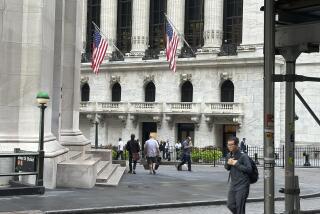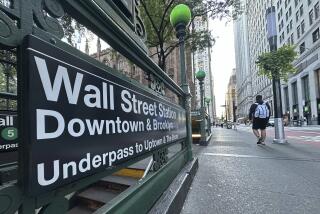Memories of the stock market crash leave investors on edge
- Share via
At times like these in financial markets, Wall Street trots out all of the usual platitudes aimed at trying to soothe investors and avert more calamity.
“It’s never smart to sell into a panic.”
“It’s a good time to hunt for bargains.”
And the classic: “You’ve got to hold on for the long haul.”
Financial advisors use these lines partly because there are kernels of truth in them. Over the very long term the stock market has gone up, of course. And indiscriminate sell-offs can produce bargains.
But these cliches also are convenient responses when no one really knows what’s happening in the markets and the economy — and when the future seems exceedingly foggy.
Confused? Frightened? Disgusted? You’re just feeling what everyone else is feeling.
Coming after a vicious drop in stock prices, many small investors suspect that Wall Street has another motive for suggesting that people hold tight: The last thing the big players want to do is encourage more selling before they have a chance to get out.
Deepening concern that the global economic recovery is fading fast has slammed markets worldwide over the last two weeks and fueled a rush for the perceived havens of U.S. Treasury bonds and gold.
The Dow Jones industrial average plummeted 513 points, or 4.3%, on Thursday, the biggest one-day percentage drop since February 2009 when the financial system still was in meltdown mode.
On Friday, the Dow managed to close up 60.93 points, or 0.5%, to 11,444.61 after the government reported that the economy created a net 117,000 new jobs in July. That’s paltry growth, but many investors were bracing for a much lower number that could have confirmed their worst fears about the faltering recovery.
Despite the speed with which the U.S. stock market has fallen in the last two weeks, the decline so far has been relatively modest. It feels a lot worse than it is.
The Dow now is off 10.7% from the multiyear high it reached in April. The broader Standard & Poor’s 500 index, a popular benchmark in 401(k) retirement accounts, is down 12% from its spring peak.
This sell-off may turn out to be just another garden-variety “correction” in a bull market — a drop of 10% to 20% that flushes some investors out of the market and sets the scene for another rally as bargain hunters come in.
But for many investors, memories of the crash of 2008-09 are painfully vivid. They recall being advised to “hold on” after the S&P index fell 10%, then 20%, then 40%, then 50%. By the time the market bottomed in March 2009, the index had lost a stunning 57% of its value from its record high reached in October 2007.
Share prices have rebounded for the last two years, but many people haven’t recovered all their losses. And having clawed back this much, it’s understandable that older investors, in particular, are petrified at the thought of facing another crash.
Markets already are in much worse shape across the Atlantic, where the European Union is desperate to avoid having to bail out the debt-ridden economies of Spain and Italy after footing the bill for bailouts of Greece, Ireland and Portugal in the last 15 months.
With government austerity the norm in Europe, hopes for the continent’s economy have faded. Stock markets in Italy, Spain, France, the Netherlands and Switzerland are in new bear markets by the standard definition: a drop of 20% or more from recent highs.
Shares in some emerging-market economies, including Brazil and India, also have tumbled this year as those governments continue to tighten credit to try to dampen rising inflation.
As investors see the value of their stock holdings shrink, the urge to play it safer becomes paramount. Though that’s typical in any market downturn, now that sentiment is intensified by memories of the last crash.
But beyond the normal desire to protect their savings, something else may be gnawing at investors: the sober realization in recent months that the U.S. economy has been unable to achieve “escape velocity” from the last recession.
Despite massive amounts of stimulus from the federal government and the Federal Reserve over the last two years, the recovery remains anemic at best.
Though much of the economic data lately have been weak, the numbers that stunned many Wall Street pros were the first-half gross domestic product growth estimates reported a week ago. First-quarter growth was revised to an abysmal 0.4% real annualized rate. The pace picked up in the second quarter, but to just 1.3%.
Most economists continue to believe that growth will accelerate in the second half of 2011. The stock market is telling us that many investors are increasingly dubious.
Once again, the focus is turning to what governments or central banks should do to bolster the economy. What investors fear is that there’s no medicine left worth trying.
Federal Reserve policymakers, who meet Tuesday, could launch another massive program to buy Treasury bonds in an effort to pull longer-term interest rates lower. But with rates already down sharply this year, it’s clear that the cost of money isn’t what ails the economy.
Indeed, the danger now is that the U.S. has fallen into a so-called liquidity trap similar to what Japan has faced since 1990: No matter how low interest rates go, fearful businesses and individuals remain reluctant to borrow and spend. The recovery can’t get meaningful traction.
That doesn’t mean another deep recession is a certainty or that the financial system is at risk of another crash.
But an economy that’s just muddling through at a low growth rate casts doubt on the speed of corporate earnings growth, and so forces investors to rethink the prices they’re paying for stocks.
So far, that’s what the market’s modest slide looks to be about: Investors are trying to sort out just how bad an economy they should be expecting. But they aren’t yet betting on recession.
Why bother with stocks at all, given the risks? As the last two years have shown, even in a U.S. economy stuck in low gear, plenty of companies will manage to succeed — if not domestically, then overseas.
Still, the market always is a gamble and there always is risk of loss. After the last week, more investors may be reconsidering their threshold for pain.
More to Read
Inside the business of entertainment
The Wide Shot brings you news, analysis and insights on everything from streaming wars to production — and what it all means for the future.
You may occasionally receive promotional content from the Los Angeles Times.










